#hindu caribbean
Text
#trinidad & tobago#caribbean diversity#anti hinduism#world anti hinduism#religious converts#india#indo caribbean#hindu caribbean#prejudice#fiji#hinduphobia
5 notes
·
View notes
Text

Hindus display their devotion to Lord Hanuman at a temple for the Hindu deity in Trinidad.
Steve Raymer
#Steve Raymer#Trinidad#trinidad and tobago#Caribbean#women#Hindu#Hinduism#religion#hanuman#south america#west indies
12 notes
·
View notes
Text

6 notes
·
View notes
Photo
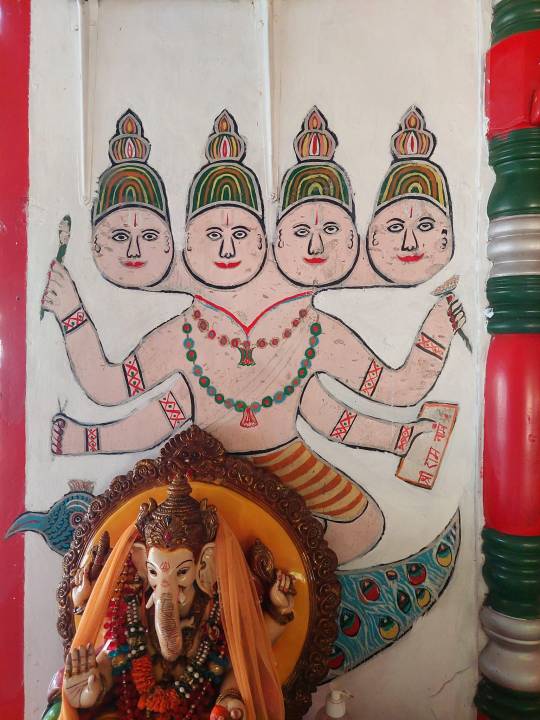

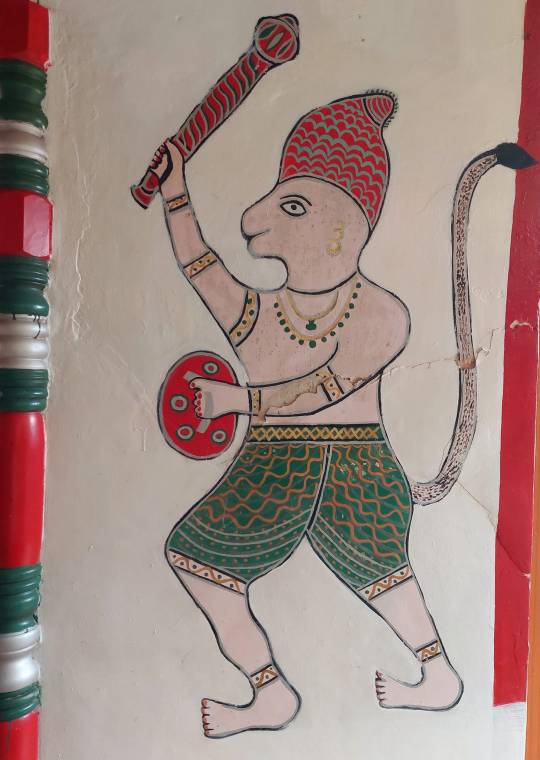

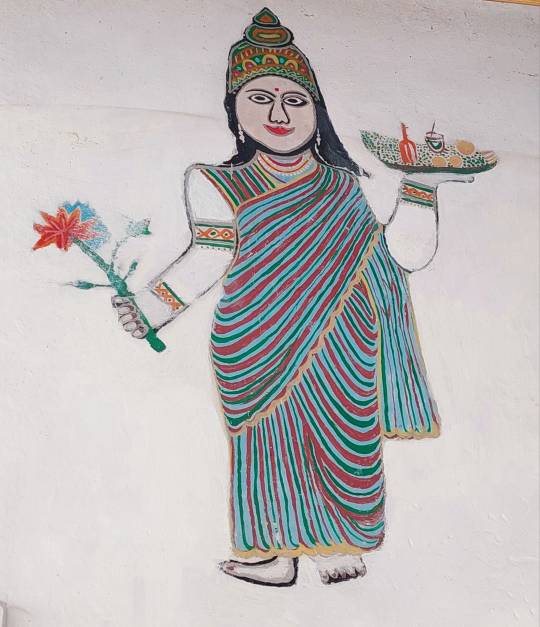

Sexypink - From the Facebook page of Niala DB
On this Indian Arrival Day (May 30th 2023), I present you with original artwork- temple murals - from the Indentured ancestors which have been preserved on the walls of the Moose Bhagat Hindu Temple, George Village Tableland. This religious and once tribally-important building was constructed by Pundit Mahandat Moose Bhagat Dass in 1904 and is preserved by his descendants, although it seems the pundit line is no more. This temple is written as being the second oldest in the Caribbean ( I do not have the facts to confirm this).
I don't share DNA with this possible ancestor-in law, but I thought the journey worthwhile. I feel I see a Bhagat clan resemblance in the faded photo of Moose but, that might just be wishful thinking. It was a joy to behold the art of the ancient Indentured from India. I wonder how old were the artists?
May they all continue to sleep in peace, giants they once were.
#sexypink/Indian Arrival Day 2023#sexypink/Indian murals in Trinidad#sexypink/Moose Bhagat Hindu Temple#sexypink/Indian Caribbean Art#tumblr/Indian Arrival Day#tumblr/Hindu Temple Art#hindu temple art#Trinidad and Tobago#Moose Bhagat Hindu Temple#tumblr/Moose Bhagat Hindu Temple#hindu history#hindu art history
3 notes
·
View notes
Photo
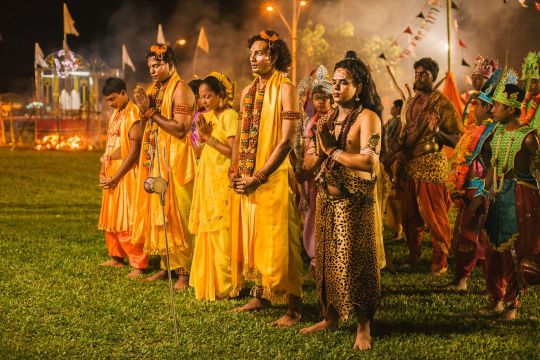
Diwali in Trinidad, 2012 by Roger Seepersad
#Diwali#Trinidad#Trinidad and Tobago#Caribbean#Indo Trini#Indian Diaspora#Hindu#Hinduism#Religion#2012#2010s#Roger Seepersad#Indo Trinidadian#culture#West Indies#West Indian
5 notes
·
View notes
Text
Prime Minister Panday's Last Parlance - Final Fiery Journey Comes Full Circle to Reconnect with Ancestors
When you came into the world, people laughed, and you cried.Go do something in life that when we die, the world weeps and we laugh.Sant Kabir Das, Basdeo Panday’s favoured Poet & Philosopher
Panday’s Last Parlance, his final fiery journey comes full circle to reconnect with his ancestors with a State Procession of compatriots from the at the Southern Academy of the Performing Arts to the…

View On WordPress
#Capacity Development#Caribbean culture education#cultural diversity#Global Diversity Inclusion Strategy#Hindu#Hindu Leaders#Indian Diasora#International Affairs#Knowledge for Sustainable Development#KrisRampersad#Prime Minister#Shore of Peace#Trindad and Tobago
0 notes
Text
Pagan Misconceptions Clarified: Why Krishna, is NOT "Only The Blue-Skinned God, That is The Reason of The Existence of The Hare Krishnas?!"
Well... Is true that this is two of his well known characteristics, but I think that Krishna is much more than his skin color; and the fervient devotion of his followers.
Krishna, is too: The God of Compassion, The God of Tenderness; The God of Protection, and... The God of Love!
Krishna, is the eight Avatar (Incarnation in the material form of a powerful Deity, God; Goddess or Spirit; on Earth) of The God Vishnu; who is the Hindu Deity that belongs to the Trimurti, (The Indian Trinity) who is in charge of preserves; protects and transform The Universe: According to myths... When the world is threatened with chaos, evil and destruction, Vishnu descends to The World as an Avatar; to restore the Cosmic Order. Of the Ten Avatars of Vishnu, two are the most important: Rama... And, Krishna! It was profesied, than Krishna will killed to his uncle; Kamsa, than was a terrible tyrant; and after his uncle couldn't killed him, he sended monsters to the child; but he defeat them one by one, including to a dark skinned giant demoness than breastfeed him; to the purpose to killed him, with her milk... Krishna killed her too, but his skin ended of being of a black or blue-skinned tone; permanently. (Just in case you was wondering, why his skin color; is showned as pitch black, or blue!) He is of a loving and playful character, and it seems playing the flute as a young man; or as a kid stealing butter to eat, as one of his lovelies mischiefs; showing than life must been live with love and fun, to make it worthy.
Krishna, is one of the most important deities of The Hinduism; and he is The Main God of The Krishnaism, which is a form of Vaishnavism; (One of the mayor Hindu denominations, which cult is around Vishnu) than is very popular in India... And, beyond!
Note: Hinduism, is a closed practices too; and if you are really interested in any of his forms, remembered to investigate ever single text; (The Vedas and Baghavad Gita, by start) learn the meaning of the symbols and terms of your desired path, and search a group of Hindus; asked them if you can join, if yes; behave in an respectful way, and take the time to learn by observing to the one than known; (be serious about it) be patient, and... Remember: The real thing, requieres time; but if you are patient, you will get there!
And now... The other atributes of Krishna!
The God of Compassion: He consolate to the hunter than mortally wounded him, and married with many women; to helps them.
The God of Tenderness: When he is depicted in art, (Specially, with Radha) he is seen showing afection in such an tender way... You can feel moved, for how sweet the scene is! (Yes... I found after being a Pagan, than I STILL have a tender side... Go figured!) He is seen with women been attentive, and for all of this... He is, The God of Tenderness!
The God of Protection: He became de husband, of 16,000 women; than after been rescued from the demon than kidnapp them, couldn't returned to their families; because they were married before, and Krishna; to avoids them misery and humiliations, decided to marry with all of them. (Very thoughtful of him, considering than most people; never desired to get married, with somebody than was married before: He did this, to protected all this women of the awful treatment they could have recieved; for being without a husband!) In one story, Krishna acted as a charioter of his cousin Arjuna; to protect him during a cruel war, to prevents he got wounded or kill. In another myth, he protected to a woman that was pregnant; when a horrible man pointed his deadly weapon against her, because he wants to kill the baby in her womb; who was one of the last survivors of an enemy tribe. For these stories and more, he is; too... The God of Protection!
The God of Love: For the aforementioned story of the 16,000 women, than he atracted women with his music and beauty; and than he is generally depicted with his love, Radha... He is considered, as The God of Love!
Krishna, after participated in an important war to help to his cousin; Arjuna, innagurates a golden city with his people; where all was peace and love, called; Krishna Dvārakā: A beautiful prosperous place in an island, with many flowering gardens and lakes; where the 900,000 royal palaces were made of silver and crystal, adorned with huge emeralds; and he lived with his people; wives and sons in peace, for 36 years... Until, a hunter killed him by accident; and... The city was destroyed, by sinking in the sea. At the time of his death, he have 125 years old, preserving his youthful look. (I can only assumed, than The City was keep alive; by Krishna's Energy and Power, and while Krishna lives; all will be well, so... That explained the destruction of the same, after Krishna died.)
Sri Krishna, (as he is called, as sign of respect) have many temples through India; so if you have the chance to travel to India, and you don't know were their may be; to see to Krishna, don't worry: There are hundreds of ancient Temples of Krishna! (But, don't worry for that neither; 'cause you only have to investigates, if there is a Krishna's Temple near of your planned route; or, in the same route of your future trip!)
Krishna Janmashtami, is an Indian Festival celebrating Krishna's Birth; and Holi, is the Festival than celebrates the triumph of good over evil; and at the same time, celebrates the divine and eternal love of Radha Krishna! Both are very colorful, and are the big demonstrations of the love and respect Krishna awakes; in his devotees. (If you want to go, search the festivals date online, and... Starts to prepared for your trip; to India!)
Curious fact: In Today's Indian Cities of Dwarka and Bet Dwarka, were found satellites towns and an City-State; (The last one underwater) than mades to the archaeologists and investigators to concluded; than the submerged city-state, could be... Dvārakā! The fascinating finding, appeared in an episode of a series of The History Channel; called "Underwater Worlds", and; if you hasn't seen it yet... You have too, if you believe in your heart; than Dvārakā, existed! (...It is really worthy to see it, by the way: I was mad with joy, even hours after the episode ended!)
In my opinion... Krishna, is a being than embody the supreme qualities of Compassion; Tenderness, Protection, Playfulness, Resilience; but, his major quality... Is Love! And, I'm not talking only about romantic love; but about Love, in general: When he is only a boy, he protects to the inhabitants of his city; he protects and guide to his cousin to do what is right, he put to his grandfather in the throne after being unfairly put in jail; and he even forgived to the hunter than wounded him, before to die. He embody filial love, love for others; love to the ones than makes a big mistake, and is a love than doesn't demand nothing in return; is transparent and sincere, and goes beyond the material love: Spiritual, eternal and pure love; for all!
This is all, about the God than is revered in India; and in many temples around The World, for his Love and Kindness; towards Humanity: Krishna!
Have all of you a life of Joy, Love; and of choose always being Kind, first... So Be It!
#pagan writings#pagan writer#pagan misconceptions clarified#indian gods#hindu gods#hindu god krishna#hindu god krishna is not only his skin color#krishna deity#pagans#pagan#eclectic pagan#ecletic pagan#hellenic pagan#lokean#pagan from the caribbean
1 note
·
View note
Text
New England college-aged brothers Daxton and Brandon White were -art tomb a little too much. Their dad always joked, when they misbehaved, “I’m gonna sell you to the Sheik.” And , throughout their lives, the boys always laughed at that. As IF their dad could, or would, sell them off to live with a Middle Eastern royal. Well, Dax and Bran’s first semester grades were pitiful. Seemed like the brothers couldn’t stop partying enough to make their way to class and went to the gym every day instead.
Bill White had done some work overseas, as a military contractor. And Bill was beginning to think his sons needed a lesson of perspective. So Bill, early on, before he was even married, found himself rubbing (hairy) elbows with the Arab elite, back in the Gulf War days. In fact, Bill had spent time with Sheik Qadar. Sheik Qadar had even come into possession of an ancient changing stone.
One day the boys got picked up from the gym by their dad’s companies’ “fixer,” Mr. Nadir. Nadir took the boys to the airport and shipped them off, first to the city Bursa, Turkey, where they lived each day as a new hairy Arab. Then they were taken overseas to the Caribbean to wake up daily as black man who lives their lives as online influencers personal training the wealthy arabic vacationers. Next, the boys were shipped of the UAE where they did the same, learning arabic with their thick Eastern Caribbean accents. Gosh, it was getting difficult for them to remember English after becoming so used to speaking Arabic. Lastly, they were sent to India where Daxton and Brandon completely forgot being white Americans, but were able to remember their lives as Caribbeans and Arabs.
Dakaar and Brishaan now are being picked up by a man they’ve never met, Mr. nadir, to be taken back to America. Oh, so sad how the boys were crying and scared, not wanting to leave their homeland of India. Dakaar soothes his younger brother and tells him, in Hindu “we’ll be okay, brother. We must obey this new life with our new master in America”
The trick is on Bill, who assumed his sons would eventually regain their life as his white American sons… three years later the Indian brothers are just as unable to attend school, since they only English they now know are the names of the machines in the gym and the only counting they can do is May decidable by the numbers on the side of weight plates and dumbbells. Bill is doing his best, though, to teach his boys English. They get tutored by handsome blonde university men every day.
💚💚💚
#abdullah broshairif#male tf#ai generated#reality shifting#race change#white tf#age progression#age regression#hairy chest#indian tf#arab tf#black tf#hairy indian man#hairy middle eastern#hairy forearms#hairy arms#hairy shoulders#morph tf#muscle tf
30 notes
·
View notes
Text



David Rios Ferreira’s new permanent artwork “Landscapes adrift— cosmically woven and earthly bonded” at 7 Av (F,G) station in Brooklyn incorporates elements of science-fiction, the natural world, architecture, and history across approximately 700 square feet of glass mosaic. Inspired by the station's proximity to Prospect Park, Ferreira drew inspiration from the snapping turtles and red-eared sliders that inhabit the park. These turtles hold significance in creation stories shared by Indigenous peoples such as the Lenape and those of the Northeastern Woodlands, as well as in Hindu and Chinese mythologies, where the earth is believed to be carried on the back of a giant turtle. Building upon this narrative and drawing from his own Taino heritage (the Indigenous people of the Caribbean), Ferreira's artwork seeks to bridge present-day concepts of home with a shared cultural connection to the planet across time.
Ferreira's mosaics feature amalgamations of abstract and representational images of turtles, drawing from a variety of interpretations found in scientific journals and Indigenous cultures. These images intertwine with recontextualized depictions of neighborhood maps, buildings, landmarks, and plants. The vibrant backgrounds of the mosaics utilize iridescent glass, creating a captivating shimmering effect reminiscent of swirling algae in lakes, while also evoking a sense of the otherworldly and cosmic. Ferreira's artwork takes viewers on a fantastical journey that mirrors the experience of commuters traveling through the station.
📸: Pedro A. Estevez
32 notes
·
View notes
Text
Introduction to Sara la Kali, Saint of displaced people.

Sara la Kali is the patron saint of the Romani people. She is venerated primarily in Saintes-Maries-de-la-Mer, a town in the Camargue region of southern France, which is a significant pilgrimage site for the Roma community.
Her domain as a saint consists of displaced people, refugees, migrants, people who were/are oppressed & the Romani people. She is a symbol of hope for the oppressed.

According to her legend, Sara was a servant of the three Marys (mainly her mother, Mary Magdalene), who helped them (with the help of an angel) to arrive in France by a small boat, fleeing persecution of Christians after Jesus' death. She is also said to be Jesus' secret daughter, hidden from the patriarchy for her safety.
In one legend, Sara supported the Marys by begging while they were busy teaching Christianity to the locals. In another legend, when the Marys were still on their journey and caught in a storm at sea, Sara spread her cloak to save them.
Yet another legend has it that Sara was not a servant, but a Roma queen who already lived in the south of France and welcomed the arrival of the Marys and Christianity.
In another version, there were more people on the boat: Mary Salome, Lazarus, Joseph of Arimathea, and Jesus' followers, who set out to sea in the small boat with no oars, sails, food, or water.
This is where Sara comes in. In this version, Sara was a maid to Mary Jacob. As the small boat carrying her mistress drifted out to sea, Sara was deeply heartbroken, thinking she had been left behind in a land devastated by war & persecution. When Mary Jacob saw Sara distraught and crying, she threw her cloak over the waves. Sara grabbed it and was pulled into the boat with the others.

Where did she come from?: When the Romani people were persecuted and forced to convert to Christianity, they blended their indigenous Hindu beliefs with Christian practices, creating a form of syncretism. The romani at that time were mostly Shakta Hindus, and worshipped the goddess Kali-ma.
Since Kali-ma was so important to them, they transformed/disguised her as a Christian saint, and called her “Sara Kali”. Sara is a blending of different traditions, Kali-ma and the Black Madonnas/marys.
Another thing that traces back to her origin as a dharmic goddess is her halo, which is the dharmachakra (wheel of the law).

Sara shares traits with other Black Madonnas and dark, feminine divinities in Latin America, the Caribbean, Africa, etc. She is often called "black mother" (just like Kali-ma's name, which literally translates to that).
the Roma have been persecuted as unwelcome migrants from India, facing violence wherever they go. Despite this, their patron Saint Sara has provided hope and identity to the more than 12 million members of the Roma diaspora around the world.
Every year, thousands of Roma gather in Saintes-Maries-de-la-Mer to honor her with a procession and various rituals. In one of her rituals, She is immersed in the water just as the Hindu goddess Durga is every year in India. The Romani venerate her as their queen, but she is also a mother to all the local Catholics who feel a connection to her.
Sara Kali's personal veneration by the Romani brings cures of sickness, good luck, fertility, success in business ventures, and protection.
Other names/titles she goes by: Saint Sarah, Saint Kali, Sara E Kali, black mother, Mother of the Romani, secret child of Jesus, sati-Sara, Queen of the Romani, protector of the oppressed, brown sara, sara the black, Sarah the Egyptian

Ave Sara La Kali... mother of the Romani
#sara kali#Sara e kali#Sara la kali#christianity#Saint#folk Saint#romani#Hinduism#Shaktism#sanatandharma#religion#kali#kali ma#kalika#Devi#Devi kali#maa kali#syncretism#displaced people
10 notes
·
View notes
Text
flower/plant in dramas
Prompted by the conversation I had with @colourme-feral about plumeria and jasmine being featured in the first episode of I Feel You Linger in the Air (and also, plumeria was featured in KinnPorsche during the scene with Khun Spikes our beloved), I was tempted to write this post. Honestly, I always love to see how flowers or plants or even parks (not theme-parks) are used in dramas. Flowers and plants give visual localities and in many cases it's a part of natural and cultural elements of a place where the drama is set. And for me, it is always interesting to see how people 'place' their priority on parks, or to some extent, forests, through a piece of media; are they treated just as a side / decorative elements (as an escapade, or simply a break, destination, maybe), or as center stages? (Sorry, I was once an architecture/landscape architecture graduate and still, until today, have this default interest towards these living elements -- tropical flowers and forests my beloved! --, and since I LOVE watching my Asian shows, how they were presented there - will I always write about them, though, that's another case.) So, I am thinking of making some posts about flowers in dramas (specifically in Thai dramas). As I focused more on the Southeast Asian context, I might miss some facts about of the flower(s) from the perspective of other regions, but hopefully I didn't leave out anything significant.
part 1 - plumeria/frangipani
Plumeria (or also popular as frangipani) is a genus of flowering plants native to the Neotropical areas (including Mexico, Central America, the Caribbean, Brazil, and Florida in the US) but had been spread throughout the warm tropical regions as ornamentals. I'm not going to list its different types of species but given that Plumeria is known more as a common name, here's a list of how the flower is also called across Southeast Asia's region: Frangipani, Cempaka, Kemboja, Bunga kubur (Malaysia); Kamboja (Indonesia); Kalachuchi, Kalasutsing-puti, Kalasutsing pula (the Philippines); Lan-thom-khaao, Lam-thom-daeng, Lee-laao-dee (Thailand); and Dai (Vietnam). Please feel free to correct me if you see any of these names to be wrong.
There's no clear evidence on how and when exactly the plants came to Southeast Asia, however, two temples in Indonesia (one built in the 9th century and the other in the 14th century before the European came to the region) had the flower trees depicted in their relief.
In Southeast Asia, both the flower and the trees of Plumeria are considered sacred. The flower is strongly associated with religion and temple life in both Hindu and Buddhist cultures, for examples, it is used by the Balinese Hindus in their temple offerings.
The Plumeria is also linked to ghosts and graveyards in the Philippines, Indonesia, and Malaysia where the trees are often planted at cemeteries both to give shading and to function as signage. Bunga kubur, one of the known names of Plumeria in Malaysia, literally means cemetery/graveyard (=kubur, or kuburan in Indonesian) flower (=bunga). Locals believe that the flowers give shelter to ghosts and spirits. In Malaysian-Indonesian folklores specifically, the flower's fragrance is even associated with a certain type of mythological creature that is a vampiric spirit (who likes to hang out on the trees), thus the flower often perceived as bad luck.
However, on the other side, Plumerias are also commonly used as ornamental plants in houses, parks, parking lots, and other open area as part of the elements of modern landscaping.
This interesting article compiles five interpretations of Plumeria flower meaning across various cultures, those are: (1) Peace, joy, and warm welcomes; (2) Openness to new relationships or loyalty to existing ones; (3) Ties to death and immortality; (4) Fertility, rebirth, and femininity; and (5) Medicinal healing powers.
The article above, with additional information taken from here, said that in Thailand, the way they would say Plumeria (ลั่นทม / lân-tom) was similar to the word for 'sorrow', or 'gloomy, sad, and depressed' (ระทม / rá-tom). This might be why the flower had a negative meaning to the people or community in the past and considered an unlucky plant. However, this perspective is changing and now Plumeria (or Frangipani) has a new name that is ลีลาวดี / Lii-laa-wá-dii/Lee-laao-dee.
Lastly, here's another article that talks more about Kalachuchi (another name for Plumeria) flower.
the flower in dramas:
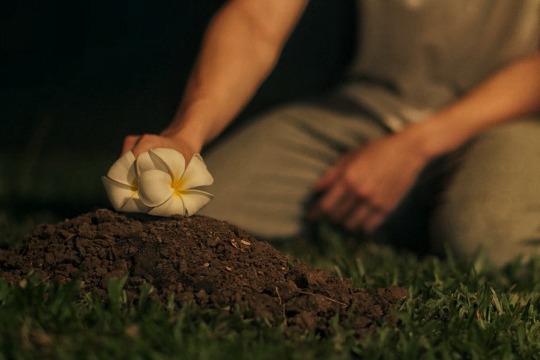
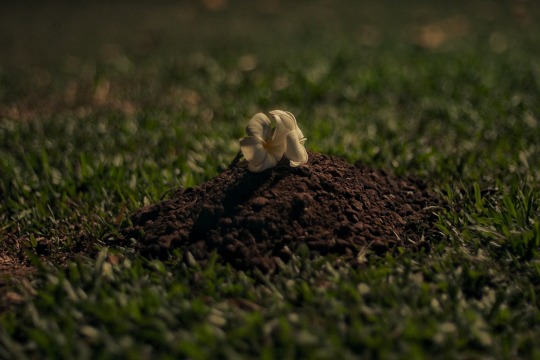
KinnPorsche -- Remember our Khun Spike. Plumeria flowers here were used as offering or signage on top of the grave.

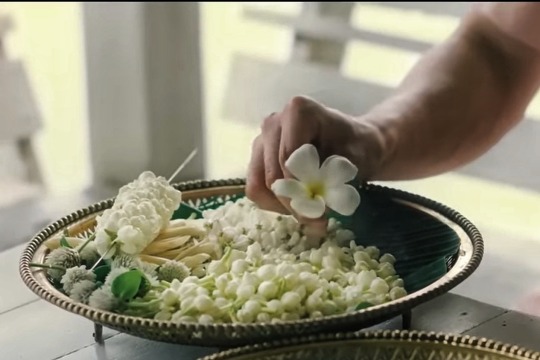
I Feel You Linger in the Air -- A Plumeria flower here was used as a prop, depicted falling from the sky onto the top of a plate of jasmines. It might hold some symbolisms: a welcome, an openness, or transfer of 'spirit' or soul across the time dimension.
Next, I plan to write about jasmine (Part 2) and hibiscus (Part 3).
Sources: [1] [2] [3] [4] [5] [6] [7] and the book "A Field Guide to Tropical Plants of Asia" by Engel & Phummai, 2008.
#flower in dramas#flowers#tropical flowers#plumeria#frangipani#i feel you linger in the air#kinnporsche#i'm tagging the shows for organization purpose#*this is why i don't write much here it took me so long to compile things i wanted to say :')
40 notes
·
View notes
Text
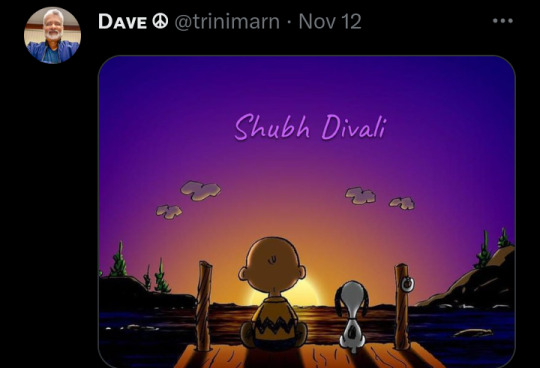
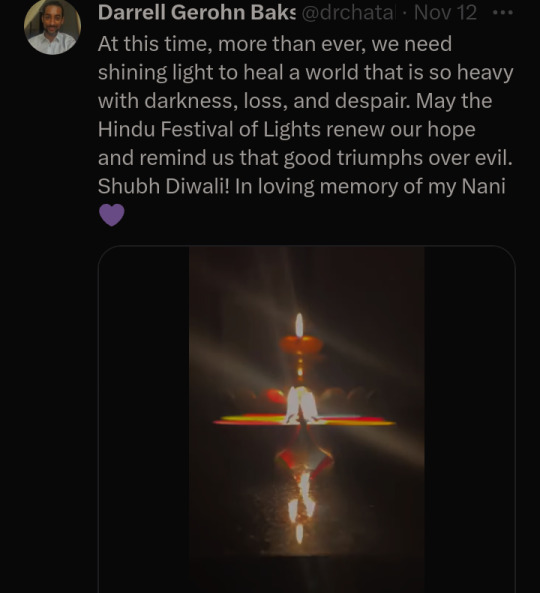
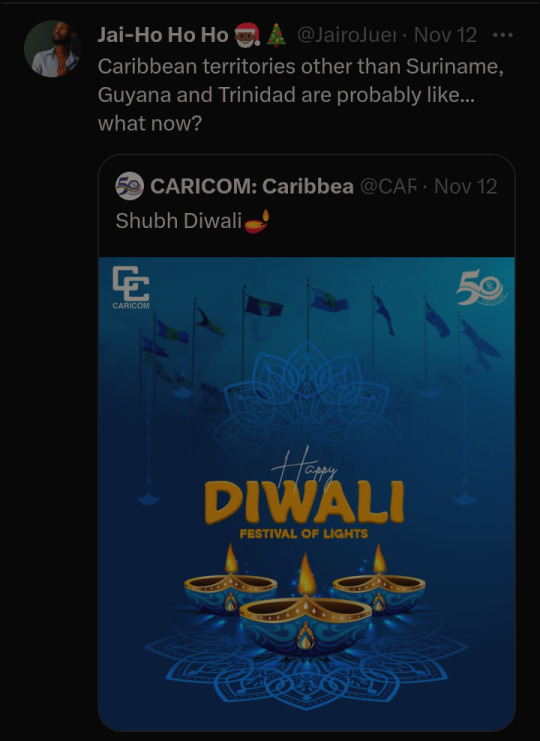
#divali#diwali#deepavali#hindu#hinduism#hindu caribbean#indo caribbean#religion#religious holidays#trinidad & tobago#guyana#suriname
0 notes
Text
For Indo-Caribbean communities, the stories of Hanuman and Rama echo history.
Despite Rama being forced to live in exile, Hanuman remained a loyal devotee. “Because we’re a people that were displaced from our homeland and sent to the Caribbean, we connect to the story differently and see Hanuman as the epitome of a devotee,” says Vinay Harrichan, the founder of Cutlass Magazine, a publication dedicated to the Indo-Caribbean community.
Hanuman’s dualities, of peace and ferocity, playfulness and protectiveness, also reflect Indo-Caribbean history. “When [Hinduism] made its way to the Caribbean, it suddenly became a minority religion with colonialism and the impact of missionaries,” Harrichan says. “One thing that was always central in Indo-Caribbean Hinduism was that we are a peaceful, loving, accepting people, but we're also fierce in protecting our beliefs and the things that we hold sacred.”
excerpt from “Who is Hanuman, the Hindu god with the face of a monkey?”
17 notes
·
View notes
Text
Setting Map: Viceroyalty Latinidad (REWORK)

CorpEmp Macrocommunities:
Aridoamerica: Northwest Mexico. Miffed they didn't get the Rio Grande, even in the 2800s.
Central America: Central America plus Panama minus El Salvador.
Chile: Rump Chile run by Tradcath Gremialists. At least they don't have to deal with the Mapuche anymore...
Grand Bajio: North-Central Mexico. Home to massive Neo-Chichimec and Purépecha industrial estates.
Gran Colombia: Colombia, Ecuador, and Venezuela. Bolivar was a corporatist all along!
Hispanola: Haiti, Dominican Republic, and Puerto Rico. The only islands of the Greater Antilles that weren't seized by the U.M. and W.C.O.F..
Indo-Caribbean: Trinidad-Tobago and the Guyanas. The Hindu Heartland outside of VR Jambudvīpa.
Kalingo Archipelago: The Lesser Antilles (sans T-T and Montserrat), home of Carib restorationist movements.
Matto Grosso: Brazil's Center-West. Like to see themselves as the heirs of old Brazil.
Maya: Yucatan, northern Guatemala, and Belize.
Mesoamerica: Central Mexico. Declared the Nahua and Zapotec homelands, dotted with Hispano-Gaelic enclaves.
Nordeste: Brazil's northeast. Finally free from Brazilian internal neocolonialism.
North Rio Grande: Coahuila, Nuevo Leon, and Tamaulipas. Once a Texan satellite state, its relationship with the First Dynasty's home made the N. Rio Grande an influential member of VR Latinidad following its formation.
Paraguay: Slightly larger now that it's acquired the Argentine Chaco. Provinces like styling themselves as the old Jesuit Reductions.
Patagonia: Southern Argentina and Chile, the homeland for the Mapuche people, as well as some Welsh enclaves.
Peru-Bolivia: Peru and Bolivia, back together! Styles itself as Neo-Incan, with a few acquired Japanese stylings.
São Paulo: Formed from the Brazilian state, plus Minas Gerais. One community of note within is the "Confederado Tribal Zone".
(South) Rio Grande: Southernmost Brazil. Lots of German, Italian, Polish, and Ukrainian enclaves.
Tucumán: Northern Argentina. A Neo-Diaguita and Tonocote project.
Non-CorpEmp Territory:
Cordons Sanitaire: The Falklands, Mexico City, Brazil's Federal District, and a large buffer zone between Buenos Aires (U.M. territory) and Uruguay (W.C.O.F.).
Green Consensus: A good chunk of the Amazon, Galapagos, and a restored Montserrat.
United Markets: The militarist Milleist Free State (Buenos Aires), Central America's Crypto Coast, Jamaican FVEM , and the Sandals-Bahamas Free Market Zone.
World Congress of Freedom: The Zapatista Federation (Chiapas), Cuban Republic, the Rio-Santo strip (Brazil), and Peoples Republic of Uruguay.
Reserves: Millenarianist, pacifist, and survivalist enclaves across the Viceroyalty, and several (formerly) uncontacted peoples in the Amazon.
CPC Activity: Organized criminal groups use the Mexico City and Brasilia Cordons Sanitaire as staging grounds for trafficking operations. Massive depots are usually seen built and rebuilt in the Amazon. Several descendants of Guantanamo detainees have formed pirate groups in the Caribbean.
15 notes
·
View notes
Text
Day 4 @tolkienlatamandcaribbeanweek (Dwarves, Religious diversity): The Seven Clans
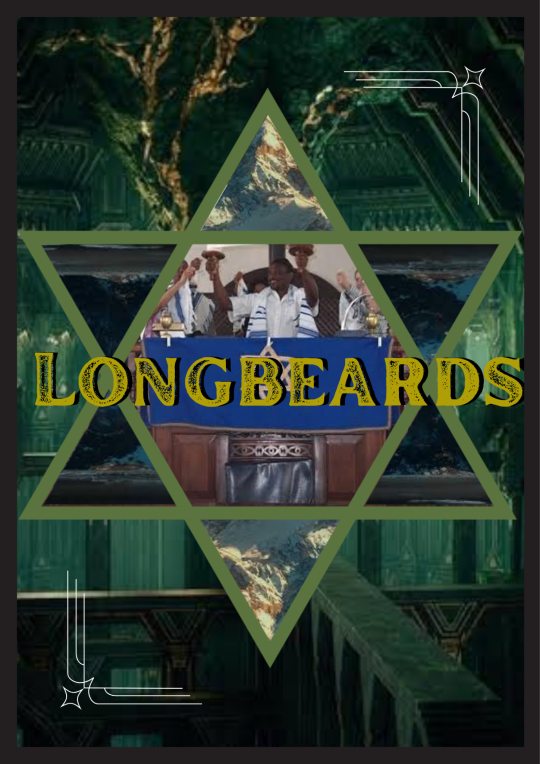


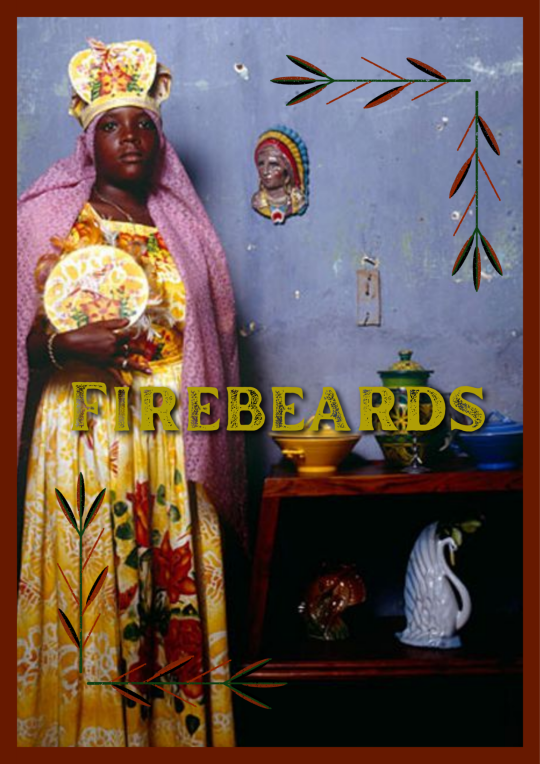



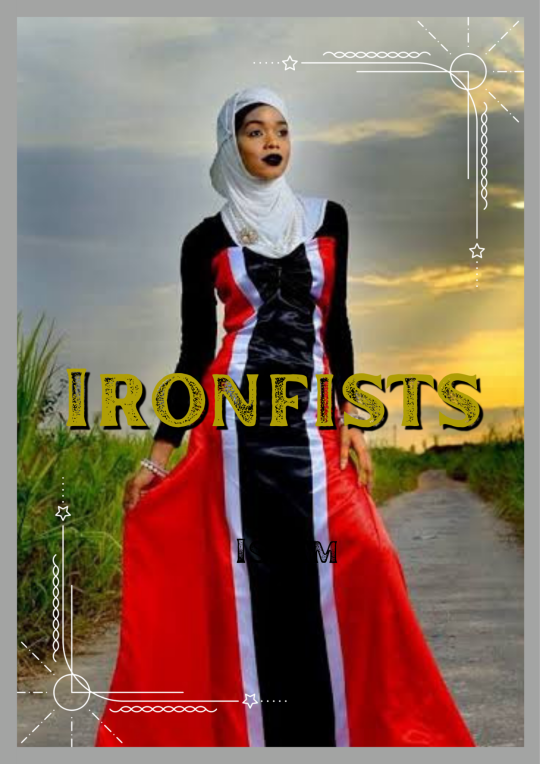



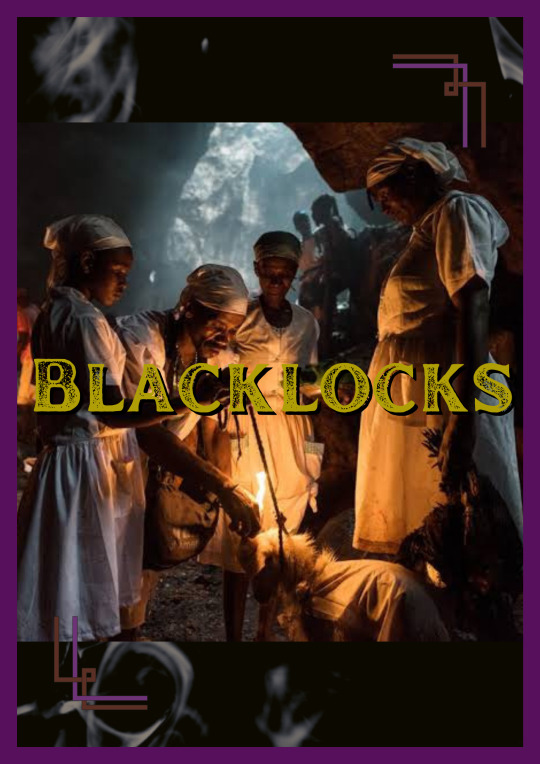


My day 3 and day 4 entries will be out of order due to computer problems. For day 4 I decided to represent the seven dwarf clans with seven different religions
Part 9 of toi's indigenous tolkien series
[id: images in rows of two.
Row 1 left: text 'Longbeards'. Photo of Jamaican Jews in the middle of a Star of David. The points of the triangle are parts of a photo of the mountain of erebor. Background is from the hobbit movies, a shot of inside of erebor. Row 1 right: Jewish cemetery gate with a star of david, somewhere in the Caribbean
Row 2 left: a santeria altar. Row 2 right: a Black santeria practitioner, text 'Firebeards'
Row 3 left: crowd of black brazilian women in white dresses practicing candomblé. Row 3 right: black and white photo of candomblé altar
Row 4 left: photo of mosque. Row 4 right: woman in hijab and a dress made like a Trinidad and Tobago flag, text 'Ironfists'.
Row 5 left: Taino person in a feathered headdress with necklaces, text 'Stiffbeards'. Row 5 right: art showing Zemi figures (believed to have held religious significance to ancient taino)
Row 6 left: purple Haitian vodou flag. Row 6 right: Haitians practicing vodou underground by firelight, text 'Blacklocks'.
Row 7 left: two indo-caribbean women from the 1800s, text 'Stonefoots'. Row 7 right: unspecified hindu temple
end image description.]
#dwarves#the hobbit#lotr#latam + caribbean tolkien#jewish tolkien#black tolkien#muslim tolkien#indigenous americas tolkien#south asian tolkien#tolkienlatam&caribbeanweek#moodboards and edits#toi's indigenous tolkien series#toi's creations#contains image description#the third age#mepoc
92 notes
·
View notes
Text
American White Religious trauma as a result of Christianity is so annoying because it pervades all discussions of religion generally. That even when religion is used as a motif, it's always assumed to be an allegory to Christianity. (The American evangelical kind or rarely Catholicism) And in fandom, this sentiment is worse. Don't you know religion is bad, duh!
The issue with this is when you put a lens of intersectionality (specifically as a black femme) or you use a lens of assemblage (non black femme) then you get the understanding that the issues non white people have with religion is not the issues White people have. Christianity is Hinky because of its roots in colonial rhetoric and justification, but that's not the issues white people have with Christianity. (This is not to say that exploitation of children and women but churches aren't egregious - they are. But this, conversion isn't about that) its like the anti-religious sentiment is spread everywhere affecting Muslims, Jews, Hindus, Buddhists, Sikhs, Rastas and more, everyone is just catching stray bullets. Religion has to be bad for the non right wing American people, but so much of the good of religion is lost in that discussion. Also there's never the nuance to say hey maybe religion is funked up because America is fucked up? People do fucked up things and try to justify it by any means? Its hard because I grew up religious, left the church and now I'm very much into taking what I need spiritually from wherever, and to be honest that may be the privilege of my culture. But church was a necessary ecosystem and solace many a time, just as mosque was and I think what's scary is that because White people by and by don't really cultivate community and social culture (argue with your mum not me) the social aspect of religion and religious community isn't extended out? Take for example the Sikhs of my local area also give food from the Langar of our local gurdwara and I've known alot of these aunties and uncles since I was a babe. I've eaten there as has so many other homeless people and local business people etc because the food is good, the music bops and the jokes are hilarious. We're community. And when the time comes now at different parts of the year to give back we do, we have to because we're in community. It's mad in my eyes to have all this discourse on religion and never speak of the good things. No one ever talks of breaking fast with friends from school and how exciting it is to be invited round for iftar, or making eid cards at getting to celebrate, giving gifts at Christmas or making gingerbread etc with other people or singing carols. It's always about the fuckeries of religion and never that when people who have little else but God, do amazing things with wonder and hope. Granted, all of this was the privilege of living in a town outside of America that whilst was very small was incredibly diverse and maybe the fact that America is a continent disguised as a country with racial segregation still likely plays a massive part in the PR for christinanity? I say this because the Black church never gets its dues for what it did for the Black community in America and that's probably because overwhelmingly the PR for Christianity in America is White and right wing likely. Like what about Rasta's with political liberty in Jamaica and the Caribbean or Hinduism for the Tamil is religion just white people and Christianity?
Ultimately, I want to have a discussion about it without that specific white lens because religion for us who were colonised and dispossed is completely different.
Still, the general consensus in fandom that all religions are bad by virtue of whitenessess relationship with Christianity is absolutely mad, but what do I know?
I'm a black person on the Internet.
8 notes
·
View notes